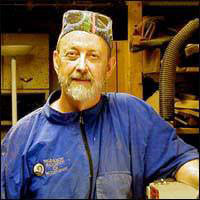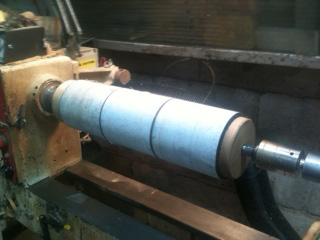An Improvised Sanding Drum

by Phil Colson
Woodturner
I turn spatulas. The turning is simple enough but a sanding drum is needed to finish the flat sides. I didn’t want to purchase a stationary belt sander, because I have very little room in my shop, so I made a sanding drum out of PVC and high-density foam that is powered by the lathe. I used hard maple to plug the ends of the PVC and then mounted it on a faceplate and used the tailstock for stability. Here's how I made it:
I found a piece of PVC pipe that was three and a half inches in diameter (and I mean I found it). You could use a larger diameter but I would not go any smaller. I cut the PVC to a length of thirteen and three quarter inches so it would accommodate three pieces of four and a half inch PSA sandpaper. I buy the paper in rolls. The grits I use are 80, 120, and 220. Make sure you cut the PVC square; I used my 12" mitersaw.
I cut my high-density foam about 1" wider than the length of the PVC and about ½" longer than the circumference of the cylinder. Getting the circumference of the cylinder is as easy as putting a mark on the inside of the PVC, locating the mark at the leading edge of the foam and rolling the PVC until it has moved one revolution and don’t forget to add the ½".

|
The disks are made of any hardwood; I used 8/4 maple. I cut out two disks on the bandsaw larger than the diameter of the PVC pipe. I used a screw center chuck to mount one of the disks to my lathe and trued up the disks to the outside diameter of the PVC. I used a faceplate for the other disk. I used calipers to get the inside dimension of the PVC and then parted a shoulder to that dimension. The shoulder should be about 1". Test each disk while it is on the lathe to see that it fits before you unscrew it from the chuck. I glued the disks into the PVC with medium CA glue, putting a bead of glue on the inside of the PVC and then pushing the disks into the ends of the PVC. I then put the cylinder aside to let the CA glue set.
Next I applied contact cement to both the PVC and the foam. When the contact cement is dry to the touch, it is ready to put together. The extra 1" of foam is the fudge factor allowing less stress in the glue up – as you know once both pieces touch, it’s stuck. I centered the PVC with the foam and rolled it up. I slowly started pressing the foam onto the PVC, and continued until the foam overlapped. Next I took a sharp knife (a razor blade would work too) and slowly trimmed the overlapping foam. Now if you happen to cut it uneven and there are small gaps in the seam, don’t worry, it won’t affect the sanding.
Finally I put my new sanding drum on the lathe. I rotated the drum at a slow speed and trimmed both ends to square it up with a sharp skew or knife (it really doesn’t matter about the ends, it just looks good). Sand on, McDuff!
Next issue I'll show you how I turn spatulas.
Phil can be reached directly via email at
woodturnerphil@gmail.com
.
Take a look at
Highland Woodworking's great selection of Woodturning products.
Return to
The Highland Woodturner
front page


